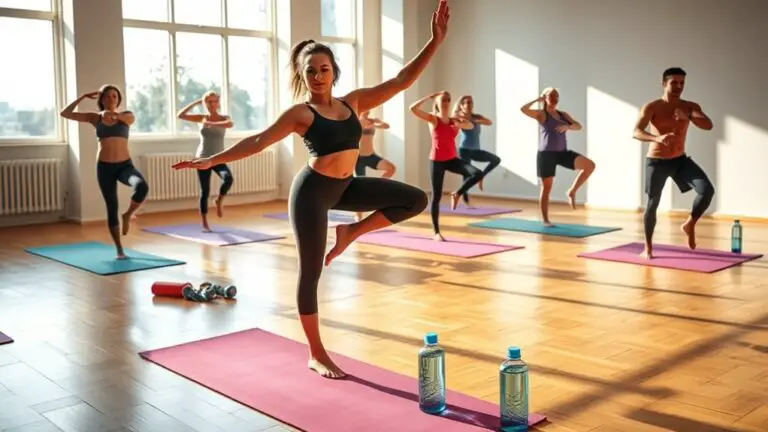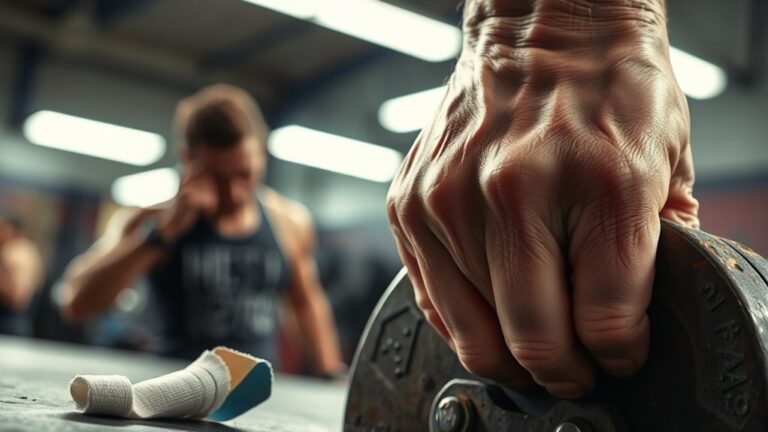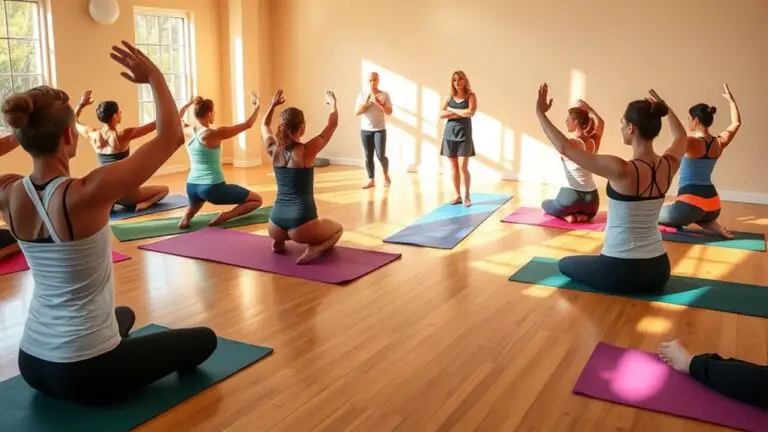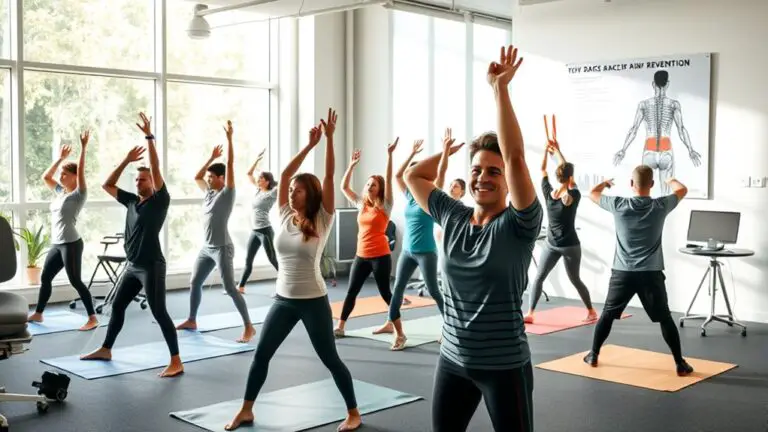The Best Yoga Poses for Gym-Goers
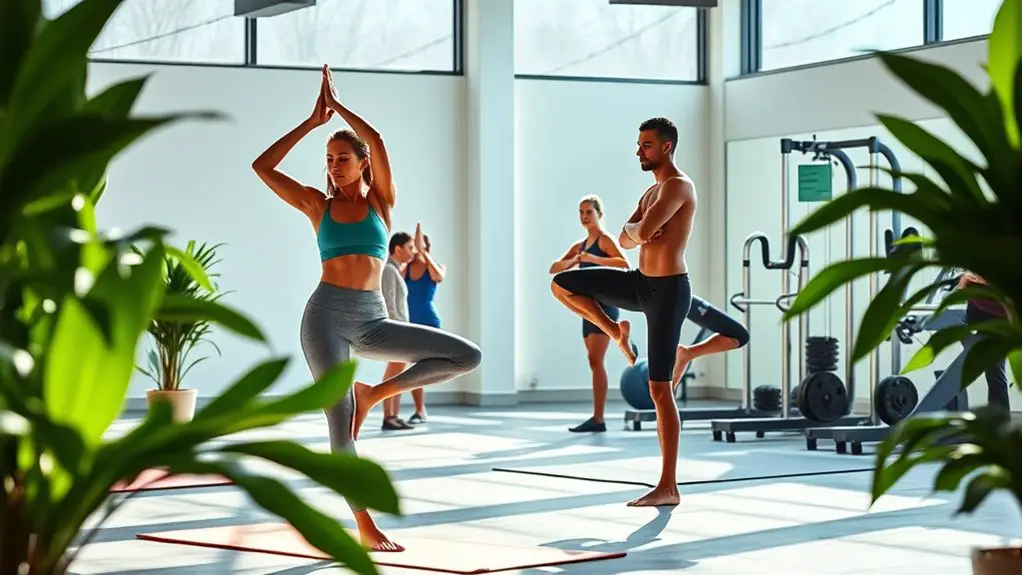
If you’re hitting the gym regularly, yoga can dramatically enhance your performance! Poses like Downward Facing Dog boost flexibility, while Pigeon Pose eases hip tightness. Warrior II builds strength and focus, and Bridge Pose aids in recovery. Don’t forget Cobra to energize, Seated Forward Bend for relaxation, and Legs-Up-The-Wall to rejuvenate post-workout. Integrating these plays into your routine not only complements your strength training but also fosters a balanced mind and body approach. There’s so much more to discover!
Benefits of Yoga for Gym-Goers
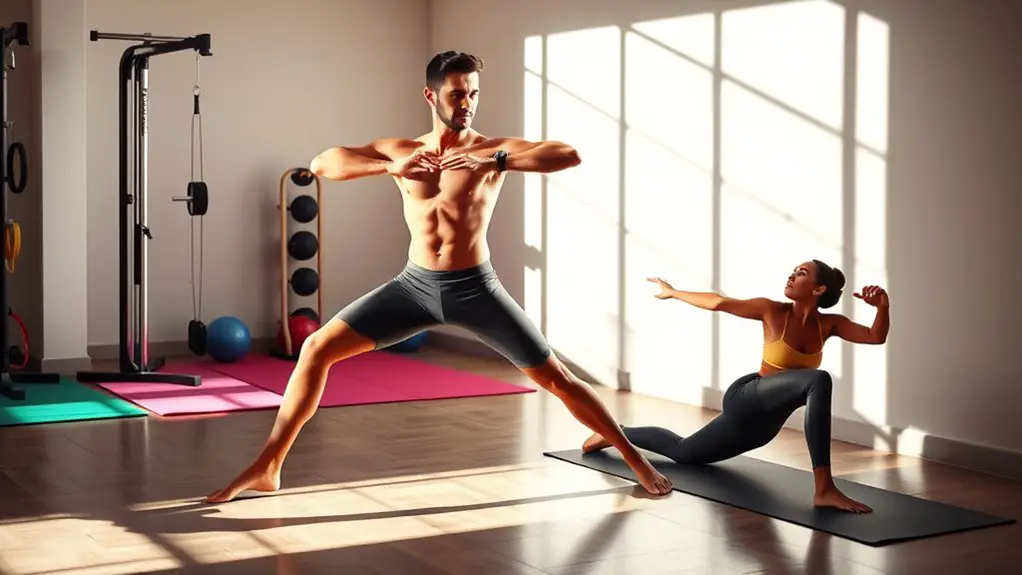
When you think about enhancing your gym routine, integrating yoga might not be the first thing that comes to mind, but it can be a game-changer. Yoga offers a myriad of benefits that complement your strength training and cardio workouts. By incorporating yoga into your regimen, you can improve flexibility, helping you achieve deeper, more effective lifts.
Additionally, yoga plays a significant role in muscle recovery. The gentle stretches and restorative poses encourage blood flow and reduce soreness, allowing you to bounce back faster between workout sessions. It also promotes mental clarity and focus, which can lead to better performance during your gym workouts.
Downward Facing Dog
Integrating yoga into your routine can enhance your overall gym experience, and one of the most effective poses to include is Downward Facing Dog. This pose not only stretches your hamstrings and calves but also strengthens your arms and back, promoting better posture and flexibility.
Here are some engaging yoga variations to reflect upon:
| Yoga Variation | Benefits |
|---|---|
| Downward Dog Split | Increases hip flexibility |
| Three-Legged Dog | Engages core muscles |
| Dolphin Pose | Strengthens shoulders |
| Puppy Pose | Stretches spine and shoulders |
| Extended Puppy Pose | Deepens chest opening |
Incorporating Downward Dog into your routine can help you recover from intense workouts and prepare your body for more challenging exercises. So, roll out your mat and embrace the benefits of this dynamic pose!
Pigeon Pose
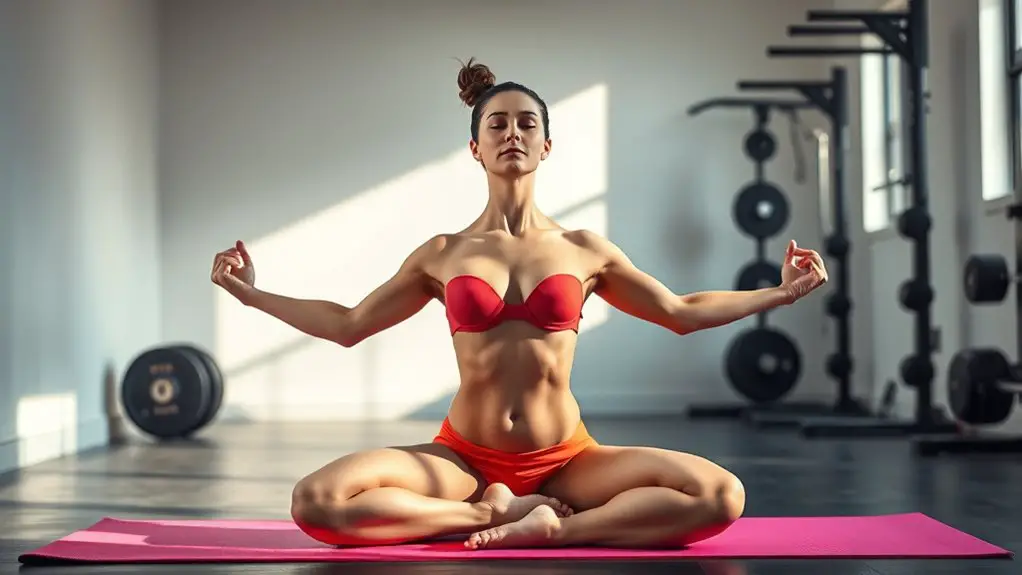
If you’ve been hitting the gym hard, your hips might feel a bit tight, and that’s where Pigeon Pose comes in. This powerful stretch not only helps release tension but also promotes proper alignment, enhancing your overall flexibility. Let’s explore how to master this pose and free those stubborn hips for better performance!
Benefits for Tight Hips
Tight hips can be a common challenge for many gym-goers, but the Pigeon Pose offers a powerful solution. This pose is fantastic for enhancing hip flexibility, which is essential for overall mobility improvement. By stretching the hip flexors and glutes, Pigeon Pose helps release tension built up from intense workouts. You’ll find that practicing this pose regularly not only alleviates tightness but also improves your range of motion, making your gym sessions more effective. Plus, it encourages a deeper connection to your body, helping you better understand your physical limits. So, roll out your mat and embrace the benefits of Pigeon Pose—your hips will thank you, and you’ll feel more agile and ready to tackle your next workout!
Proper Alignment Tips
To maximize the benefits of Pigeon Pose, ensuring proper alignment is essential. Start in Downward Dog, then bring your right knee forward, placing it behind your right wrist. Your right foot should be angled toward your left hip. As you lower your hips, keep your left leg extended and your toes pointed. Focus on maintaining a straight spine; try not to collapse forward. Engaging your core helps with stability and promotes better yoga alignment. If you feel tightness, gently ease into the pose to enhance your gym flexibility. Remember to breathe deeply, allowing your body to relax and release tension. Switch sides, and you’ll notice the difference in your hips and overall mobility. Enjoy the journey!
Warrior II
Warrior II is a powerful pose that not only builds strength but also enhances your focus and balance. To maximize its benefits, you’ll want to guarantee proper alignment, which can prevent injury and improve your overall performance. Let’s explore how to get into this pose correctly and why it’s a must-try for your gym routine.
Benefits of Warrior II
While you might be familiar with various strength-training exercises, incorporating the Warrior II pose into your routine can greatly enhance your overall fitness. This powerful pose cultivates warrior strength, helping to build and tone your legs, core, and arms. As you hold the position, you’ll develop stability and endurance, which translates well to your gym workouts.
Moreover, Warrior II encourages warrior focus, sharpening your mental clarity and concentration. It teaches you to remain present, which is essential during high-intensity gym sessions. The deep breathing involved in this pose can also reduce stress and improve your overall well-being. By integrating Warrior II, you’re not only enhancing your physical capabilities but also fostering a strong, focused mindset that empowers your fitness journey.
Proper Alignment Techniques
Achieving the full benefits of Warrior II hinges on proper alignment techniques. When you focus on yoga alignment, it enhances your strength and stability, ensuring you’re safe while practicing. Here’s a quick guide to help you maintain alignment in Warrior II:
| Alignment Aspect | Tips | Importance |
|---|---|---|
| Front Knee | Keep it over your ankle | Prevents strain |
| Back Foot | Press down firmly | Stabilizes the pose |
| Hips | Face forward | Opens your torso |
| Shoulders | Relax and drop them | Reduces tension |
| Gaze | Look over your front hand | Improves focus and balance |
Bridge Pose

Bridge Pose is a fantastic addition to your workout routine, offering numerous benefits for gym-goers. This pose strengthens your glutes, hamstrings, and lower back while enhancing flexibility in your spine. By incorporating bridge pose variations, like the one-legged bridge or the elevated bridge, you can target different muscle groups and keep your practice fresh and engaging.
As you flow into this pose, you’ll not only build physical strength but also promote better posture and alleviate tension from your workouts. Plus, bridge pose benefits extend to your mental well-being, helping to reduce stress and anxiety.
To get started, lie on your back with your knees bent and feet flat on the floor. As you lift your hips toward the ceiling, engage your core and breathe deeply. Embrace the empowerment this pose brings, and watch how it complements your overall fitness journey!
Child’s Pose
Child’s Pose is a gentle yet powerful resting posture that can provide gym-goers with a moment of respite amid their intense workouts. This pose not only helps stretch your back and hips but also encourages deep relaxation and mental clarity.
Child’s Pose Benefits and Modifications
| Benefits | Modifications |
|---|---|
| Relieves tension in the back | Use a cushion under your hips |
| Calms the mind | Widen knees for more space |
| Stretches the spine | Place arms alongside or overhead |
Incorporating Child’s Pose into your routine can enhance recovery, allowing you to recharge both physically and mentally. If you find it challenging, don’t hesitate to try the modifications listed above. Remember, it’s all about listening to your body and finding what works for you. So, take a moment to unwind in Child’s Pose, and feel the benefits wash over you.
Cobra Pose
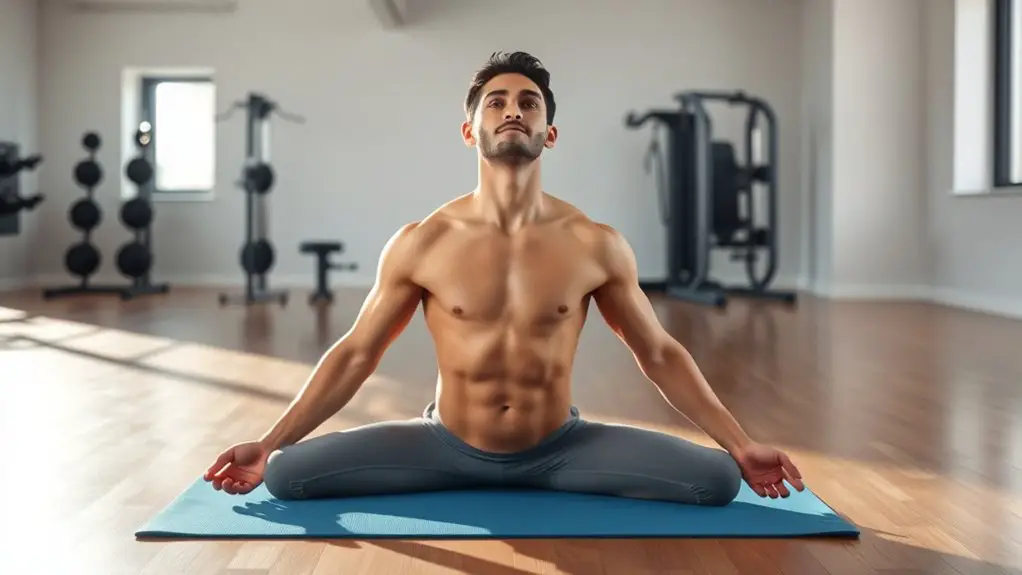
Cobra Pose is a fantastic addition to any gym-goer’s routine, offering a dynamic stretch that targets the spine and opens up the chest. Incorporating this pose can enhance your workout recovery and boost your overall flexibility. Here are some cobra pose benefits you won’t want to miss:
- Improved spinal flexibility: Regular practice helps maintain a healthy spine and reduces stiffness.
- Chest and shoulder opening: It counteracts the hunched posture often developed from weightlifting.
- Enhanced energy: This pose stimulates the adrenal glands, helping to combat fatigue.
You can also explore cobra pose variations, like Upward-Facing Dog or Sphinx Pose, to keep your practice fresh and challenging. Whichever you choose, integrating Cobra Pose into your routine can provide significant physical and mental benefits. So, roll out your mat and enjoy the invigorating effects of this powerful pose!
Seated Forward Bend
While you might think of the gym as a place for high-intensity workouts, incorporating the Seated Forward Bend into your routine can provide a welcome balance. This pose is a fantastic way to stretch the hamstrings and lower back after those heavy lifting sessions. Sitting on the floor, you’ll extend your legs in front of you, inhale deeply, and as you exhale, gently fold forward, reaching for your feet or shins.
This forward fold not only enhances flexibility but also promotes relaxation, reducing stress and tension accumulated from intense workouts. You can explore various seated variations, adjusting the depth of your fold based on your comfort level. Remember, it’s not just about how far you can reach but about connecting with your breath and being present in the moment. By integrating the Seated Forward Bend into your regime, you’ll find harmony between strength and flexibility, improving your overall performance in the gym.
Legs-Up-The-Wall Pose
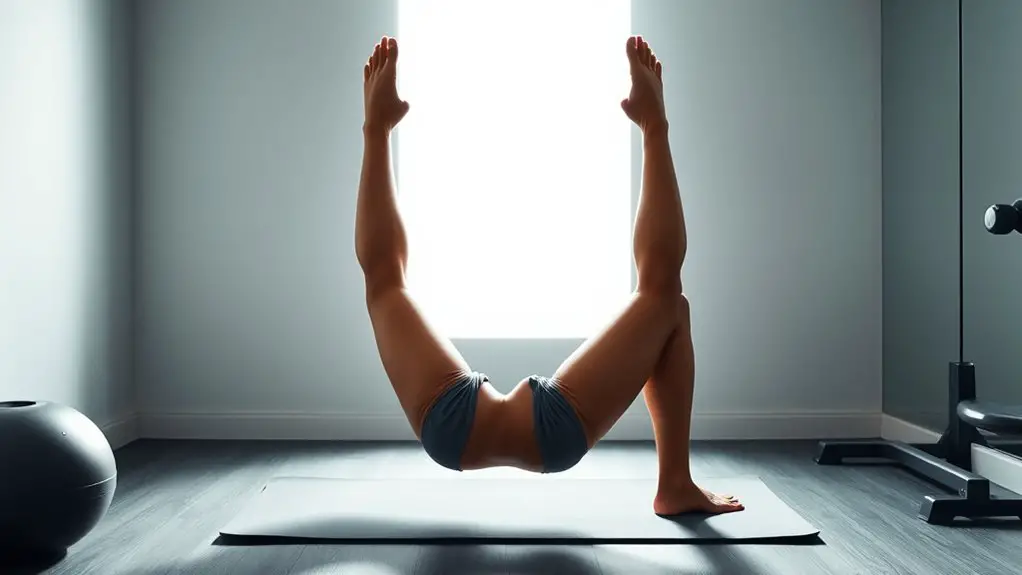
If you’re looking to unwind after an intense gym session, the Legs-Up-The-Wall Pose is a perfect choice. This restorative pose offers incredible inversion therapy benefits that can help relieve tension and rejuvenate your body. Just find a wall, lie on your back, and elevate your legs. You’ll feel the stress melting away!
Unwind after your workout with the Legs-Up-The-Wall Pose, a restorative practice that rejuvenates your body and melts away stress.
Here are a few restorative benefits you can enjoy:
- Improves circulation: Elevating your legs helps blood flow back to the heart, reducing swelling.
- Relieves tension: This pose can alleviate lower back pain and tightness in the legs after workouts.
- Enhances relaxation: By engaging the parasympathetic nervous system, it promotes a sense of calm.
Incorporating Legs-Up-The-Wall into your routine is an easy way to boost recovery. So, take a moment after your gym session to give your body the break it deserves!
Frequently Asked Questions
Can Yoga Help Improve My Weightlifting Performance?
Absolutely, yoga can greatly improve your weightlifting performance! The yoga benefits, like increased flexibility and core strength, create a powerful weightlifting synergy. By incorporating yoga into your routine, you’ll enhance your range of motion, reduce injury risk, and boost recovery. Plus, the mindfulness cultivated through yoga can sharpen your focus during lifts. So, why not give it a try? It could be the secret ingredient to elevating your weightlifting game!
How Often Should I Practice Yoga for Best Results?
Finding the right balance in your yoga frequency is essential to reaping the benefits. Think of it as watering a plant; too little or too much can hinder growth. For ideal practice, aim for at least two to three sessions a week. This’ll help improve flexibility, strength, and mental clarity. Remember, consistency is important—so don’t be afraid to mix it up with different styles to keep your practice fresh and engaging!
Is Yoga Suitable for Beginners?
Absolutely, yoga’s suitable for beginners! You’ll find its benefits are immense, from increased flexibility to reduced stress. Start with simple poses and listen to your body. Beginner tips include focusing on your breath and not pushing your limits too quickly. It’s all about progress, not perfection. Remember, every expert was once a beginner. So, grab a mat, enjoy the journey, and discover how yoga can enhance your overall well-being!
What Should I Wear to Yoga Class?
You wouldn’t show up to a dance-off in jeans, right? When it comes to yoga class, choosing the right yoga attire is key. Go for breathable fabrics like cotton or moisture-wicking materials that allow for flexibility and comfort. Avoid overly loose clothing that can get in the way. Remember, the right fit and fabric can enhance your practice, helping you focus on your poses rather than adjusting your outfit. You’ve got this!
Can I Do Yoga After an Intense Workout?
Yes, you can definitely do yoga after an intense workout! In fact, it’s a great way to enhance your yoga recovery. Gentle stretches and poses can help alleviate muscle tension and improve flexibility, promoting a better workout balance. Just listen to your body—if you’re feeling too fatigued, opt for restorative poses instead. Incorporating yoga post-workout can rejuvenate you, making your fitness routine more holistic and enjoyable. So, roll out that mat and unwind!
